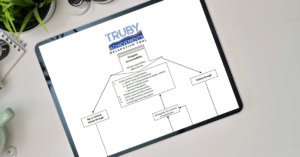How to Manage Low Performers

Last Updated on March 25, 2024 by Bill Truby
What to Do When a Few Low Performers Affect the Entire Team
Different people perform differently – that’s normal. Differing ability, experience, or training can cause this. Even though some individuals may have a lower “output” level than others, each person is performing up to his or her ability. This is not the kind of negative impact “low performance” we’re talking about in this article.
Accounting for differences in ability as well as training, learning, and growing, is all a part of the normal dynamics on a high performing team. But there can be major problems when there are low performers because of the lack of accountability, laziness, bad attitude, or even rebellion. This can have a huge, negative ripple effect on your entire team.
Generally, you can place individuals who work for you into three categories: high, medium, and low performers. If there are low performers in your team, they are typically few in number, yet they take up an inordinate amount of management time and create a disproportionate amount of negativity in the entire team. Low performers must be dealt with.
If low-performing individuals are not dealt with it causes a negative ripple effect in the team and possibly the entire company. Following are some of the effects you might observe.
Effects of Low Performers
- Low performing individuals are often the negative or complaining ones. They tend to drain energy from the rest of the team and cause others to focus on problems rather than solutions.
- Team members know the low performer(s) exist(s) and tend to talk about it thus perpetuating gossip and complaints and lowering morale.
- Team members see clearly how the low performers are not functioning efficiently, and that causes a “why should I work as hard as I do” attitude. This limits the effectiveness of an otherwise higher performing individual.
- Managers or other team members have to correct the mistakes or solve the problems caused by lower-performing team members reducing efficiency and increasing complaints.
- Leaders are often criticized for not dealing with the low performer thus causing trust to diminish or leadership effectiveness to be questioned.
High performing individuals make major contributions but are typically few in number. Medium level performers often make up most of the team. Low performers can be few in number but will have a strong, negative impact on the team. They can decrease morale, influence others to work less, and limit the ultimate potential of the entire team.
The way to deal with low performance is to identify it and eliminate it. (More on that later). The way to prevent low performance is by using various accountability tools: A good review system, maintaining “Contracts of Expectations” (What, by whom by when?), clarifying roles and responsibilities, and using Team Agreements – all can prevent low performance in individuals or reveal it when it exists so it can be eliminated.
Accountability tools work, but they only work after you’ve focused on identifying and eradicating low performance and/or low performers. Notice the distinction? Our goal is to eliminate low performance in individuals. If that can’t be done, then the low performer must be terminated.
The following system will help you deal with low performers.
How to Manage Low Performers
This system is designed to deal with low performers in one, quick action. The spirit of the system is this: low performance is not allowed on a team. As mentioned above, there are many accountability tools and processes that can prevent or reveal low performance. This system is the tool to “clean house” and let those tools do their job.
Step One: Identify low, medium, and high performers
In privacy, each leader/manager would consider each team member and rank them as to low, medium, or high performance. This may be a subjective exercise with the manager considering a variety of criteria including items such as “likeability,” but there must be some objective criteria that the manager can speak to when talking to a team member.
Here are some examples of objective criteria that identify low performers: Not putting in a full day’s work, not producing as much as others in a similar role, taking too long of breaks, not finishing tasks, significant project overruns, very poor billable performance, client dissatisfaction, not fulfilling contract of expectations, and any other behavior that results in weak performance.
At the end of this step, the manager has a list, which only he or she sees. This list clearly categorizes team members in one of three areas: low, medium, or high performance.
Step Two: Individual meetings with each team member
There are some dynamics the manager needs to consider when deciding to deal with low performers. Notice the following facts:
- Low performers cannot be dealt with in isolation. Since low performers cause a ripple effect in the entire organization, the entire team needs attention.
- A corporate culture that has allowed low performers to emerge undoubtedly has had others “slip” into being “middle” performers who used to be high performers.
- High performing people may have become a bit demoralized or deflated because of the presence of low performers.
Because of all of these facts, it is important to deal with low performers within the context of meeting with each individual on your entire team.
At step two; the manager tells the team that there will be a meeting with each employee to determine “how things are going” and to discuss the employee’s work and goals within the company. It is important to state something like this: “This is not a normal employee review. Our concern surrounds some weak performance in the company. We want to talk to each person about that and how we can improve. These meetings are to further each person’s individual effectiveness so our team can function with maximum success.”
After the announcement the manager would have a meeting with each individual; ideally on the day of the announcement and within a short time frame so as to not cause rumors or risk misinterpretation. During the meeting, a variety of issues can be discussed, such as:
- Are you getting everything you need to do your job effectively?
- How do you view the efficiency of the company and your team?
- Is there anything else I can do as your leader and manager to help you?
- Anything else specific to your company and the individual’s role.
As you engage in the above questions, and other content that may come up, you may be able to gather some important general information you were unaware of. Your communication may also provide content that can be referred to as you speak about the real reason for the meeting – that of dealing with performance issues.
As you move into specific content about performance it is important not to overtly label the individual with words such as, “You are one of my high performers,” or “I called you in today because you are a low performer,” and certainly not, “I have divided the staff into three categories called low, medium and high performers – you are in the “x” category…”
You already know what category each person is in – high, medium, or low performance. Following are the guidelines for talking to a person in each category.
Guidelines for Meeting with the Three Levels of Performers
Low Performers:
Be clear and specific about how the employee is underperforming. Express your desire to have the person continue to be on the team. Make it clear that underperforming behavior will not be tolerated. If you have not been clear before or timely in delivering this message, own up to that. Apologize for the delay but don’t let that become an excuse for continued low performance.
After telling the employee what is not going to be tolerated, detail the kind of behavior or performance you do expect. Be clear and specific. Give the team member something to strive for. Explain the tools you will use for accountability and schedule check-in meetings to ensure compliance.
In short; the message here is that low performance is unacceptable and must stop!
Medium Performers:
These employees typically make up most of the staff. They are to be thanked for their performance and possibly challenged to become higher performers. Support any and all improvement ideas.
The message to a medium performer is not to work harder at doing the same thing. Instead it is, “What can I do to help you achieve a higher level of performance personal satisfaction for you in your role?” In essence, you are raising the bar for the medium performer stating specifically the economic or visionary reasons and providing assistance to achieve that higher goal.
In short, medium performers tend to stagnate. The manager is nudging them with a challenge to become higher performers.
High Performers:
Recognize the specific contributions of the high performers in terms of behavior and attitude. Look for ways to support and assist them as they continue to make the company successful.
It is also helpful to ask high performers to duplicate themselves. Set them up as trainers in specific tasks or skill sets. Allow them to mentor or in other ways build other team members.
Step Three: Consistently use the tools and processes that prevent or reveal low performance.
Low performing individuals are squeezed out of a high performing team by illumination, stating expectations clearly then following up with frequent accountability meetings. This allows the person to become a higher performer. If the low performer doesn’t step up to the plate, they, by choice or discipline, will leave the team. It is imperative that you be firm and consistent in applying accountability tools.
The benefits of this process are these:
- Eliminates low performance, and in some cases, low performers
- Medium performers are challenged to become high performers
- High performers are challenged to duplicate themselves
… All of which creates a consistent, high performing team.
While you are reviewing your team to consider performance, it’s also important to make sure that you are delegating effectively and are not making matters worse.
To learn how to effectively delegate, download our free easy-to-use delegation flow chart. Following this flow chart will make an immediate improvement in your team’s performance as well.

Learn More about this Free Tool

Did you find this article valuable? Take a few moments to evaluate the effectiveness of your team before and/or after making these recommended changes with this free assessment.
You can also follow us on Social Media for more content:
LinkedIn | Facebook
Bill Truby
Founder and President of Truby Achievements

